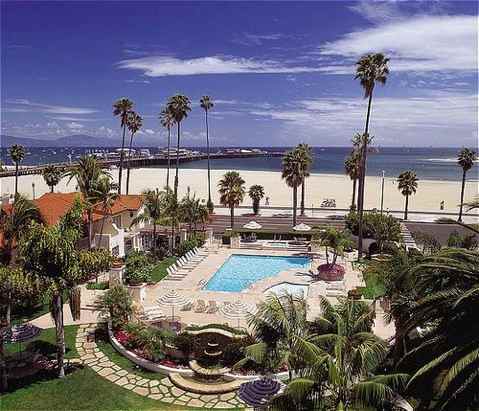It’s TBID Time Again
Santa Barbara Hotels Consider Taxing Themselves to Improve Marketing

Santa Barbara’s hoteliers are once again considering whether to impose an assessment on their room rates in order to collectively raise money for marketing. It’s not the first time such a notion has been pursued. But this time—with nearly 60 other regions in California already doing the same, including the Santa Ynez Valley, which will finalize its funding plan this May — proponents are saying that if Santa Barbara fails to act it risks losing tourists to the destinations that can afford big advertising campaigns. Opponents, on the other hand, argue that the ongoing recession is no time to raise fees on customers.
The first push to create a tourism business improvement district, known as a TBID, came at the end of last summer, when the Santa Barbara Conference and Visitors Bureau began gathering the signatures of hotel owners who would support charging $2 per night per occupied room. More than half the owners in the proposed TBID region — which covers every hotel, motel, and inn from Goleta to Carpinteria — must sign for the proposal to proceed to the public hearing phase. The City of Santa Barbara has volunteered to serve as the lead agency; other jurisdictions could then sign off with simple resolutions.
The initial $2 plan had a great deal of support, according to Tom Patton, general manager of the Ramada Inn on Turnpike Road. However, the task force, which he chairs, also heard from plenty of small property owners who believed the flat $2 fee was “not an equitable solution.” Explained Patton, “We had a high enough percentage to move forward, but we would like a higher percentage that’s more inclusive of all lodging types.”
So instead of the flat rate, Patton and his team developed a tiered assessment model. As proposed, properties with average room rates below $100 would pay 50 cents per occupied night. Those whose rooms average between $100 and $150 would pay $1. Those with rooms averaging between $150 and $200 would fork over $1.50, and those with average rates above $200 would pay $2 per occupied night. Altogether, the TBID would raise approximately $1.8 million annually, to be spent as the hotels see fit.
The signature-gathering process for this scheme started in March, and Patton hopes to start collecting by August 1. And the time is nigh, said Patton, explaining that when they started talking about a TBID two-and-a-half years ago, there were fewer than 20 in the state; today, there 57 TBIDs in existence with another 13 in the pipeline. “We will absolutely find ourselves being outspent and potentially losing market share to these other destinations,” he warned.
Patton believes the required signatures are there, but TBID detractor Tony Romasanta, who owns the Harbor View Inn, believes otherwise. “Pretty close to 50 percent of the hotels are not for it this time,” he claimed. “I’ve not been for it because this is not a time to increase a tax on your business … This is the time to be a little more efficient and take care of your customers better rather than extract more money out of them. It’s just the wrong time.” Romasanta suggested looking at the issue a year from now, when the economy has hopefully rebounded. “That’s the feeling of a lot of the owners,” he explained. “There’s a lot of positive feeling from the managers, but not from the owners of the properties who look at economics more realistically.” Romasanta said he is “not at all” threatened by the other regions that are raising money via TBIDs.
That includes the Santa Ynez Valley, which started pursuing its TBID around the time Santa Barbara first initiated the idea. The assessment is “very well supported” there, said Bill Phelps, manager of the Hadsten House Inn in Solvang. He said that the newly formed Santa Ynez Valley Hotel Association was able to get more than 70 percent of the owners to sign on, and only one hotelier actually said no. They are opting for a $2 flat-rate assessment, for their region covering the towns of Ballard, Los Olivos, Santa Ynez, and Los Alamos as well as the cities of Buellton and Solvang, which is the lead jurisdiction for this TBID and will hold the first public hearing on the matter Monday, April 12. If the final vote, scheduled for May 10, goes through as planned, they expect to raise $600,000 annually, which they intend to use to increase midweek business, since the weekends have always done well.
“We saw the writing on the wall,” said Phelps, describing the rise of TBIDs in regions surrounding the valley. “The hotels here began to realize that we are not each others’ competition, but we are the keys to each others’ success.” Once that was understood, Phelps said, everyone started to work toward the common goal of more total tourists, which is good for the hotels, good for retailers, and good for the various jurisdictions’ tax-based coffers. “By working together, we win,” said Phelps.
Patton agrees, and says that a recession is a prime time to enact a TBID for Santa Barbara. “It will provide us a stable funding source that’s not based on the funding amounts we get from the city or county, which are having their own budget issues,” said Patton. He explained that the TBID is much different from a tax that goes straight to the general fund and is spent by the city as the city sees fit. “This assessment is controlled by the hotels,” he said. “The city doesn’t have any say in how it’s spent.” Plus, the TBID must be renewed every five years, and if more than 50 percent of the owners want to stop it in any given year, they can. “If it’s not working and people don’t like it,” said Patton, “it doesn’t get renewed.”



